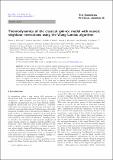Files in this item
Thermodynamics of the classical spin-ice model with nearest neighbour interactions using the Wang-Landau algorithm
Item metadata
| dc.contributor.author | Ferreyra, M.V. | |
| dc.contributor.author | Giordano, G. | |
| dc.contributor.author | Borzi, R.A. | |
| dc.contributor.author | Betouras, J.J. | |
| dc.contributor.author | Grigera, Santiago Andres | |
| dc.date.accessioned | 2016-03-04T17:40:05Z | |
| dc.date.available | 2016-03-04T17:40:05Z | |
| dc.date.issued | 2016-02-22 | |
| dc.identifier | 240605779 | |
| dc.identifier | 35e81975-4aa3-444f-83d1-3a1f426f1026 | |
| dc.identifier | 84958978148 | |
| dc.identifier | 000370875000001 | |
| dc.identifier.citation | Ferreyra , M V , Giordano , G , Borzi , R A , Betouras , J J & Grigera , S A 2016 , ' Thermodynamics of the classical spin-ice model with nearest neighbour interactions using the Wang-Landau algorithm ' , The European Physical Journal B - Condensed Matter and Complex Systems , vol. 89 , no. 2 . https://doi.org/10.1140/epjb/e2016-60781-7 | en |
| dc.identifier.issn | 1434-6028 | |
| dc.identifier.uri | https://hdl.handle.net/10023/8364 | |
| dc.description | This work was supported by Consejo Nacional de Investigaciones Científcas y Técnicas (CONICET), Agencia Nacional de Promoción Científca y Tecnológica (ANPCyT), Argentina and the Helmholtz Virtual Institute\New states of matter and their excitations", Germany. | en |
| dc.description.abstract | In this article we study the classical nearest-neighbour spin-ice model (nnSI) by means of Monte Carlo simulations, using the Wang-Landau algorithm. The nnSI describes several of the salient features of the spin-ice materials. Despite its simplicity it exhibits a remarkably rich behaviour. The model has been studied using a variety of techniques, thus it serves as an ideal benchmark to test the capabilities of the Wang Landau algorithm in magnetically frustrated systems. We study in detail the residual entropy of the nnSI and, by introducing an applied magnetic field in two different crystallographic directions ([111] and [100],) we explore the physics of the kagome-ice phase, the transition to full polarisation, and the three dimensional Kasteleyn transition. In the latter case, we discuss how additional constraints can be added to the Hamiltonian, by taking into account a selective choice of states in the partition function and, then, show how this choice leads to the realization of the ideal Kasteleyn transition in the system. | |
| dc.format.extent | 560422 | |
| dc.language.iso | eng | |
| dc.relation.ispartof | The European Physical Journal B - Condensed Matter and Complex Systems | en |
| dc.subject | QA Mathematics | en |
| dc.subject | QB Astronomy | en |
| dc.subject | QC Physics | en |
| dc.subject | NDAS | en |
| dc.subject.lcc | QA | en |
| dc.subject.lcc | QB | en |
| dc.subject.lcc | QC | en |
| dc.title | Thermodynamics of the classical spin-ice model with nearest neighbour interactions using the Wang-Landau algorithm | en |
| dc.type | Journal article | en |
| dc.contributor.institution | University of St Andrews. School of Physics and Astronomy | en |
| dc.contributor.institution | University of St Andrews. Condensed Matter Physics | en |
| dc.identifier.doi | 10.1140/epjb/e2016-60781-7 | |
| dc.description.status | Peer reviewed | en |
This item appears in the following Collection(s)
Items in the St Andrews Research Repository are protected by copyright, with all rights reserved, unless otherwise indicated.

